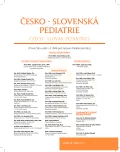Early antibiotic therapy and risk of renal scarring in children with a first uncomplicated urinary tract infection
Authors:
V. Jankó; L. Kovács
Authors‘ workplace:
Bratislava
; Detská klinika Lekárskej fakulty Univerzity Komenského a Detskej fakultnej nemocnice s poliklinikou
Published in:
Čes-slov Pediat 2017; 72 (1): 15-19.
Category:
Original Papers
Overview
Urinary tract infections are the second most common bacterial diseases in infants and children. Acute infectious tubulointerstitial nephritis (AITIN) arises as an ascending infection from the lower urinary tract and is associated with an increased risk of permanent kidney damage.
The aim of the study was to investigate the effects of febrile period before and after the initiation of antibiotics to the extent of post-inflammatory kidney damage in children with first uncomplicated AITIN.
Methods:
The cohort was composed of 221 patients aged 1 month to 18 years with first uncomplicated AITIN. In all patients the febrile interval length before and after initiation of antibiotic therapy was experienced. Renal scintigraphy was performed in 105 children after a 6-months period from overcoming the infection. The authors used the semi-quantitative analysis of the morphology scan to quantitate the extent of post-inflammatory kidney damage.
Results:
The semi-quantitative analysis revealed parenchymal defects in 113/210 kidneys, the extent of which depended on the duration of febrile period before the initiation of antibiotics (p=0.029). In 42.1% of patients the febrile interval length was longer than 48 hours. Delayed antibiotic treatment in 21.3% of children was due to the fact that the urine was not examined during the first medical examination.
Conclusion:
Our results show the importance of early antibiotic treatment in children with AITIN. They also emphasize that in a fifth of children in spite of the rapid urine test methods for outpatient clinics the urine has not been examined during the first examination for fever.
Key words:
delayed antibiotic treatment, renal scars, febrile period
Sources
1. Shaikh N, Morone NE, Bost JE, et al. Prevalence of urinary tract infection in childhood: a meta-analysis. Pediatr Infect Dis J 2008; 27 (4): 302–308.
2. Coulthard MG, Lambert HJ, Keir MJ. Occurrence of renal scars in children after their first referral for urinary tract infection. BMJ 1997; 315 (7113): 918–919.
3. Coulthard MG, Lambert HJ, Vernon SJ, et al. Does prompt treatment of urinary tract infection in preschool children prevent renal scarring: mixed retrospective and prospective audits. Arch Dis Child 2014; 99 (4): 342–347.
4. Jacobson SH, Eklof O, Lins LE, et al. Long-term prognosis of post-infectious renal scarring in relation to radiological findings in childhood –a 27-year follow-up. Pediatr Nephrol 1992; 6 (1): 19–24.
5. Mortazavi F, Rafiee A. Etiology of pediatric chronic kidney diseases in north-west of Iran. Pak J Biol Sci 2011; 13 (9): 456–459.
6. Ehsanipour F, Gharouni M, Rafati AH, et al. Risk factors of renal scars in children with acute pyelonephritis. Braz J Infect Dis 2012; 16 (1): 15–18.
7. Smellie JM, Poulton A, Prescod NP. Retrospective study of children with renal scarring associated with reflux and urinary infection. BMJ 1994; 308 (6938): 1193–1196.
8. Jakobsson B, Berg U, Svensson L. Renal scarring after acute pyelonephritis. Arch Dis Child 1994; 70 (2): 111–115.
9. Ozen S, Alikasifoglu M, Saatci U, et al. Implications of certain genetic polymorphisms in scarring in vesicoureteric reflux: importance of ACE polymorphism. Am J Kidney Dis 1999; 34 (1): 140–145.
10. Piepsz A, Colarinha P, Gordon I, et al. Guidelines for 99mTc-DMSA scintigraphy in children. Eur J Nucl Med 2001; 28 (3): BP37–41.
11. Hitzel A, Liard A, Dacher JN, et al. Quantitative analysis of 99mTc-DMSA during acute pyelonephritis for prediction of long-term renal scarring. J Nucl Med 2004; 45 (2): 285–289.
12. Hadjipanayis A, Grossman Z, Del Torso S, et al. Current primary care management of children aged 1-36 months with urinary tract infections in Europe: large scale survey of paediatric practice. Arch Dis Child 2015; 100 (4): 341–347.
13. Červeňová O. Včasnosť diagnostiky akútnej pyelonefritídy. Pediatr prax 2006; 5: 262–263.
14. Janda J, Fencl F, Šmelhausová M, a spol. Diagnostika akutni pyelonefritidy u dětí na úrovni primárni péče. Čes-slov Pediat 2006; 61: 279–280.
15. Oh MM, Kim JW, Park MG, et al. The impact of therapeutic delay time on acute scintigraphic lesion and ultimate scar formation in children with first febrile UTI. Eur J Pediatr 2012; 171 (3): 565–570.
16. Hiraoka M. Medical management of congenital anomalies of the kidney and urinary tract. Pediatr Int (Japan) 2003; 45 (5): 624–633.
17. Shaikh N, Mattoo TK, Keren R, et al. Early antibiotic treatment for pediatric febrile urinary tract infection and renal scarring. JAMA Pediatr 2016; 170 (9): 848–854.
18. Fernandez-Menendez JM, Malaga S, Matesanz JL, et al. Risk factors in the development of early technetium-99m dimercaptosuccinic acid renal scintigraphy lesions during first urinary tract infection in children. Acta Paediatr 2003; 92 (1): 21–26.
19. Shaikh N, Ewing AL, Bhatnagar S, et al. Risk of renal scarring in child-ren with a first urinary tract infection: a systematic review. Pediatrics 2010; 126 (6): 1084–1091.
Labels
Neonatology Paediatrics General practitioner for children and adolescentsArticle was published in
Czech-Slovak Pediatrics

2017 Issue 1
Most read in this issue
- Haemophilus diseases in ENT in children before and after the introduction of Haemophilus influenzae type b vaccine
- Repeated gastrointestinal bleeding
- General Movements – examination of immature nervous system
- Guideline for the Neurodiagnostic Evaluation of the Child With a Simple Febrile Seizure. Adapted Clinical Practice Guideline of the American Academy of Pediatrics
